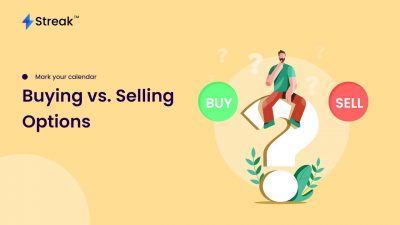Call Options Analogy

Let us try to understand call option with this analogy. Mr. Ravin bought a coupon for XYZ Garments shop by paying Rs. 100. As per the coupon, he is eligible to buy a shirt at Rs. 1,000.00 on or before 31st December.
Mr. Ravin goes to the shop on 31st december to utilize his coupon. Now let’s look at 3 different scenarios.
Scenario 1) The shirt that he wants is priced at Rs. 1,400.00 (Shirt price higher than the coupon execution price)
Let us calculate the total benefit if he uses the coupon.
Total Benefit = Cost of the Shirt – Amount he has to pay – Amount paid for Coupon =
Rs. 1,400 – Rs.1,000 – Rs.100 = RS. 300
In this case, Mr. Ravin can use his coupon to buy the shirt at Rs. 1000.00 to have a benefit of Rs. 300.00.
Scenario 2) The shirt that he wants is priced at Rs. 1,100.00 (Shirt price at the breakeven point)
Total Benefit = Cost of the Shirt – Amount he has to pay – Amount paid for Coupon =
Rs.1,100 – Rs. 1,000 – Rs. 100 = Rs. 0
In this case, his benefit is Rs. 0 but still it makes sense to use the coupon otherwise he will have to buy the shirt at 1,100.00 and he has paid Rs. 100 for the coupon also so he will be in a loss of Rs. 100. Let us use our formula to verify this:
Total Benefit (Without using the coupon) = Cost of the Shirt – Amount he has to pay – Amount paid for Coupon =
Rs. 1,100.00 – Rs. 1,100(Without using the coupon) – Rs. 100 = (-ve) Rs. 100
So here we can see that if he did not use the coupon he would be in a loss of Rs. 100.00.
Scenario 3) The shirt that he wants is priced at Rs. 1000.00 (Shirt price at the coupon execution price)
Going back to our formula, let us calculate the benefit in this case.
Total Benefit = Cost of the Shirt – Amount he has to pay – Amount paid for Coupon =
Rs. 1,000 – Rs. 1,000 – Rs. 100 = (-ve) Rs. 100
Total Benefit (Without using the coupon) = Cost of the Shirt – Amount he has to pay – Amount paid for Coupon =
Rs. 1,000.00 – Rs. 1,000.00 (Without using the coupon) – Rs. 100.00 = (-ve) Rs. 100.00
So if the shirt is priced at Rs. 1000.00, it does not matter if he uses the coupon or not. He is anyways going to be at a loss of Rs. 100 because even if he did not purchase the coupon by paying Rs. 100, he could have still purchased the shirt for Rs. 1,000.
Scenario 4) The shirt that he wants is priced at Rs. 800.00 (Shirt price lower than the coupon execution price)
If the shirt is priced at Rs. 800, it would not make sense to use the coupon and buy the shirt at Rs. 1,000. Hence Mr. Ravin will buy the shirt at Rs. 800 without using the coupon. The Rs. 100 that he paid for the coupon is a loss to him.
What do we infer?
Using the coupon is meaningful only if the price of the shirt is higher than RS. 1,000. Below Rs. 1,000.00, it does not make sense to use the coupon. Between 1000 to 1100, the losses would reduce as he would be able to recover the Rs. 100 paid for the coupon. He will benefit only if the price of the shirt is higher than 1100. Below 1000, it does not make sense to use the coupon.
What is a Call Option
An agreement between a buyer and a seller to buy a specific stock at a specific price up until a specified expiration date is known as a call option.
A call option is a contract that gives the buyer the right, but not the obligation, to buy the underlying asset at a certain price (Strike Price) on or before a specific date (Expiry Date).
The seller of the option has to oblige and sell the share at the strike price if the buyer decides to exercise the option.
Buyers pay the premium and sellers receive the premium.
In the coupon example, strike price is comparable to Rs. 1,000, premium is Rs. 100, expiry is 31st December, underlying is the shirt and underlying price is the price of the shirt.
Intrinsic Value of a call option
The premium for an option is made up of both intrinsic and extrinsic value.
When compared to the current market price, intrinsic value shows how much the strike price actually is worth excluding the extrinsic value.
Time to expiration, implied volatility, dividends, and interest rate risks make up extrinsic value.
Intrinsic Value = Price of Underlying Asset – Strike Price
If the Intrinsic Value from the formula comes out to be negative, then it is simply considered as 0. This will happen if the underlying price is less than the strike price for call options.

Call Option Payoff Diagrams

Strategy Example 1:

Strategy Link: https://bit.ly/Call_Options1
Bear Call Spread Strategy

Strategy Example 2

Strategy Link: https://bit.ly/Call_Option2
Greeks for Call Option
The following table illustrates the sign of deltas for long and short call options.

Scanner Example 1

This scanner scans for all the call options whose premiums have risen.
Scanner Link: https://bit.ly/Call_Scan1
Scanner Example 2

This scanner scans for all the call options whose open interest has risen.
Scanner Link: https://bit.ly/Call_Scan2
Conclusion
An agreement between a buyer and a seller to buy a specific stock at a specific price up until a specified expiration date is known as a call option.
Buyers of the call have a bullish view of the underlying and the sellers have a bearish view.
Spread strategies can be created using calls that have limited risk and reward.
ITM stock options are physically settled if held till expiry.
All Index options are cash settled.
Options can be bought and sold before expiry to trade the premiums.
You can easily create and backtest options strategies on the Streak Platform.
Options Strategies can also be backtested on expired options contracts on Streak.
Disclaimer: The information provided is solely for educational purposes and does not constitute a recommendation to buy, sell, or otherwise deal in investments.








